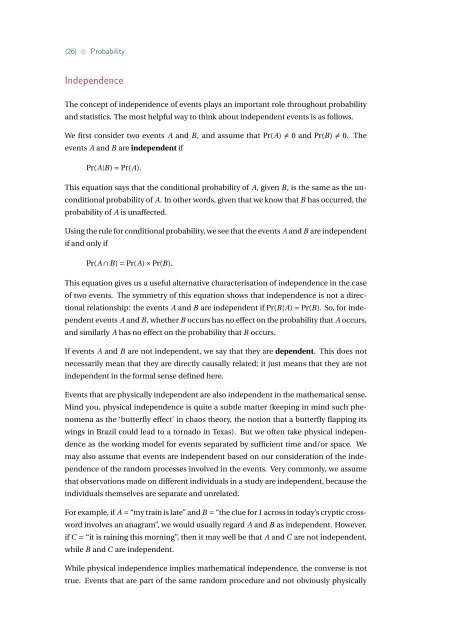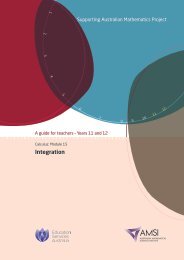Probability - the Australian Mathematical Sciences Institute
Probability - the Australian Mathematical Sciences Institute
Probability - the Australian Mathematical Sciences Institute
- No tags were found...
Create successful ePaper yourself
Turn your PDF publications into a flip-book with our unique Google optimized e-Paper software.
{26} • <strong>Probability</strong>IndependenceThe concept of independence of events plays an important role throughout probabilityand statistics. The most helpful way to think about independent events is as follows.We first consider two events A and B, and assume that Pr(A) ≠ 0 and Pr(B) ≠ 0. Theevents A and B are independent ifPr(A|B) = Pr(A).This equation says that <strong>the</strong> conditional probability of A, given B, is <strong>the</strong> same as <strong>the</strong> unconditionalprobability of A. In o<strong>the</strong>r words, given that we know that B has occurred, <strong>the</strong>probability of A is unaffected.Using <strong>the</strong> rule for conditional probability, we see that <strong>the</strong> events A and B are independentif and only ifPr(A ∩ B) = Pr(A) × Pr(B).This equation gives us a useful alternative characterisation of independence in <strong>the</strong> caseof two events. The symmetry of this equation shows that independence is not a directionalrelationship: <strong>the</strong> events A and B are independent if Pr(B|A) = Pr(B). So, for independentevents A and B, whe<strong>the</strong>r B occurs has no effect on <strong>the</strong> probability that A occurs,and similarly A has no effect on <strong>the</strong> probability that B occurs.If events A and B are not independent, we say that <strong>the</strong>y are dependent. This does notnecessarily mean that <strong>the</strong>y are directly causally related; it just means that <strong>the</strong>y are notindependent in <strong>the</strong> formal sense defined here.Events that are physically independent are also independent in <strong>the</strong> ma<strong>the</strong>matical sense.Mind you, physical independence is quite a subtle matter (keeping in mind such phenomenaas <strong>the</strong> ‘butterfly effect’ in chaos <strong>the</strong>ory, <strong>the</strong> notion that a butterfly flapping itswings in Brazil could lead to a tornado in Texas). But we often take physical independenceas <strong>the</strong> working model for events separated by sufficient time and/or space. Wemay also assume that events are independent based on our consideration of <strong>the</strong> independenceof <strong>the</strong> random processes involved in <strong>the</strong> events. Very commonly, we assumethat observations made on different individuals in a study are independent, because <strong>the</strong>individuals <strong>the</strong>mselves are separate and unrelated.For example, if A = “my train is late” and B = “<strong>the</strong> clue for 1 across in today’s cryptic crosswordinvolves an anagram”, we would usually regard A and B as independent. However,if C = “it is raining this morning”, <strong>the</strong>n it may well be that A and C are not independent,while B and C are independent.While physical independence implies ma<strong>the</strong>matical independence, <strong>the</strong> converse is nottrue. Events that are part of <strong>the</strong> same random procedure and not obviously physically
















